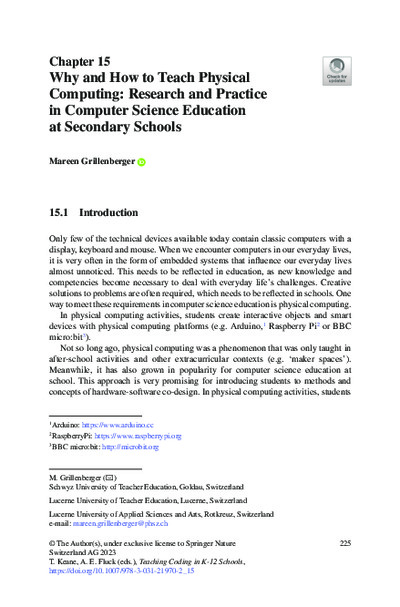Why and How to Teach Physical ComputingResearch and Practice in Computer Science Education at Secondary Schools
Publikationsdatum:
|
 |
 Diese Seite wurde seit 2 Jahren inhaltlich nicht mehr aktualisiert.
Unter Umständen ist sie nicht mehr aktuell.
Diese Seite wurde seit 2 Jahren inhaltlich nicht mehr aktualisiert.
Unter Umständen ist sie nicht mehr aktuell.
 Zusammenfassungen
Zusammenfassungen
 Physical computing is an attractive topic in computer science classes from elementary school on. With the right tools, children and teenagers actively design, create and program their own interactive objects as tangible products of learning. In physical computing, students acquire basic competences in hardware/software co-design. The focus of computer science (CS) classes is no longer on pure programming activities but shifts towards topics such as the structure and properties of embedded systems, the objectives, requirements and challenges in the design of hardware/software systems and related practices. With physical computing, it is possible to integrate such topics into constructionist and creative learning environments in a very vivid and motivating way. The purpose of this chapter is to provide an overview of what can be understood by the term physical computing from the perspective of computer science education research. In addition, it will be summarized what can be learnt from earlier research about incorporating this topic into teaching and the implications for lesson planning. Guidelines that can contribute to the success of lessons are presented, and their application is illustrated by means of tested, evaluated and revised teaching materials developed for secondary schools. Finally, with ‘My Interactive Garden’ and ‘LEGO Smart City’, two exemplary lesson series are described that incorporate the ideas presented in this chapter.
Physical computing is an attractive topic in computer science classes from elementary school on. With the right tools, children and teenagers actively design, create and program their own interactive objects as tangible products of learning. In physical computing, students acquire basic competences in hardware/software co-design. The focus of computer science (CS) classes is no longer on pure programming activities but shifts towards topics such as the structure and properties of embedded systems, the objectives, requirements and challenges in the design of hardware/software systems and related practices. With physical computing, it is possible to integrate such topics into constructionist and creative learning environments in a very vivid and motivating way. The purpose of this chapter is to provide an overview of what can be understood by the term physical computing from the perspective of computer science education research. In addition, it will be summarized what can be learnt from earlier research about incorporating this topic into teaching and the implications for lesson planning. Guidelines that can contribute to the success of lessons are presented, and their application is illustrated by means of tested, evaluated and revised teaching materials developed for secondary schools. Finally, with ‘My Interactive Garden’ and ‘LEGO Smart City’, two exemplary lesson series are described that incorporate the ideas presented in this chapter. Dieses Kapitel erwähnt ...
Dieses Kapitel erwähnt ...
 Personen KB IB clear | Erik Barendsen , Natasa Grgurina , Mareen Grillenberger , Andreas Grillenberger , Idit Harel , Sylvia Libow Martinez , Seymour Papert , Dominik Reichert , Mitchel Resnick , Ralf Romeike , Scarlet Schwiderski-Grosche , Sue Sentance , Gary Stager , Jos Tolboom | |||||||||||||||||||||||||||||||||||||||||||||||||||||||||||||||||||||||||||||||||
 Begriffe KB IB clear | Bildungeducation (Bildung)
,  Hardware Hardware hardware
, Informatikcomputer science
, Informatik-Unterricht (Fachinformatik)Computer Science Education
, hardware
, Informatikcomputer science
, Informatik-Unterricht (Fachinformatik)Computer Science Education
,  Kinder Kinder children
, children
,  Lernen Lernen learning
, physical computing
, learning
, physical computing
,  Schule Schule school
, school
,  Software Software software software
| |||||||||||||||||||||||||||||||||||||||||||||||||||||||||||||||||||||||||||||||||
 Bücher |
| |||||||||||||||||||||||||||||||||||||||||||||||||||||||||||||||||||||||||||||||||
 Texte |
|
 Dieses Kapitel erwähnt vermutlich nicht ...
Dieses Kapitel erwähnt vermutlich nicht ... 
 Nicht erwähnte Begriffe | Digitalisierung, Eltern, Informatik-Didaktik, Informatikunterricht in der Schule, LehrerIn, Schweiz, Unterricht |
 Tagcloud
Tagcloud
 Zitationsgraph
Zitationsgraph
 Zitationsgraph (Beta-Test mit vis.js)
Zitationsgraph (Beta-Test mit vis.js)
 Zeitleiste
Zeitleiste
 Anderswo finden
Anderswo finden
 Volltext dieses Dokuments
Volltext dieses Dokuments
 |  Why and How to Teach Physical Computing: Research and Practice in Computer Science Education at Secondary Schools: Artikel als Volltext @ Springer ( Why and How to Teach Physical Computing: Research and Practice in Computer Science Education at Secondary Schools: Artikel als Volltext @ Springer ( : :  , 1013 kByte; , 1013 kByte;  : :  ) ) |
 Anderswo suchen
Anderswo suchen 
 Beat und dieses Kapitel
Beat und dieses Kapitel
Beat hat Dieses Kapitel während seiner Zeit am Institut für Medien und Schule (IMS) ins Biblionetz aufgenommen. Beat besitzt kein physisches, aber ein digitales Exemplar. Eine digitale Version ist auf dem Internet verfügbar (s.o.). Es gibt bisher nur wenige Objekte im Biblionetz, die dieses Werk zitieren.





















 Biblionetz-History
Biblionetz-History